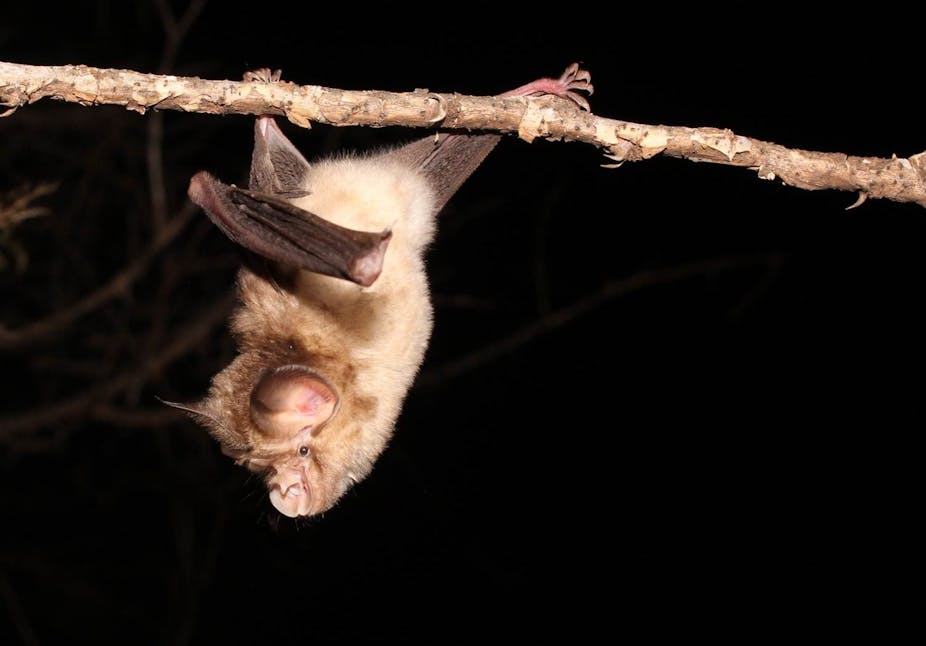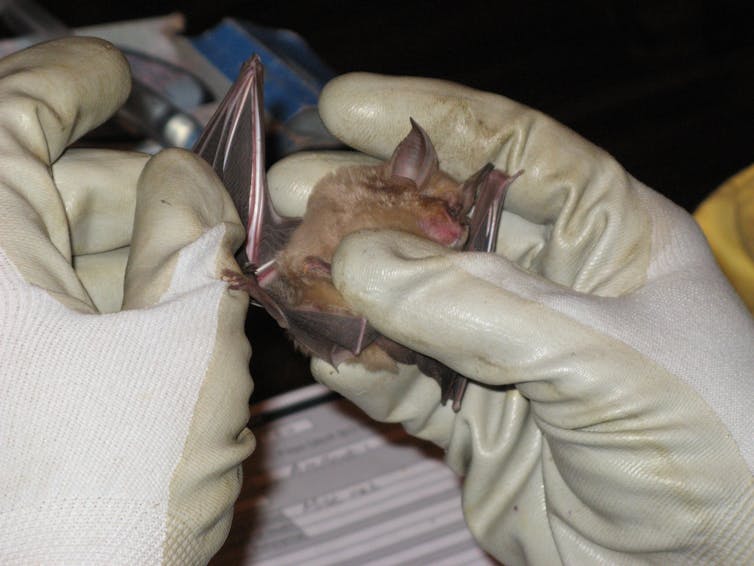Winter is coming, and for many wild animals that don't migrate or hibernate, that means it's crunch time for stockpiling food. Some creatures are famous for this, like squirrels burying nuts or pikas caching grass, while others toil in obscurity, despite their impressive — and sometimes grisly — tactics for hoarding food.
A few species defy winter's wrath by capturing live prey, for example, and keeping it prisoner in their nest or burrow. Some make their own shelf-stable food, such as honey or jerky, or turn their bodies into "living storage kegs." And even among well-known winter preppers like squirrels, humans often fail to appreciate the full complexity of what these hard-working hoarders are doing.
Here's a closer look at several animals that cache food for winter, as well as other lean times, and the elaborate methods they use to ensure their survival until spring:
Tree squirrels
 Eastern gray squirrels are famously prolific — and effective — scatter hoarders. (Photo: Tabor Chichakly/Shutterstock)
Eastern gray squirrels are famously prolific — and effective — scatter hoarders. (Photo: Tabor Chichakly/Shutterstock)
Some of the most salient winter-hoarding animals are tree squirrels, whose frantic burying and unearthing of nuts is a common sight in fall and winter. Yet these isolated glimpses of a squirrel digging in the backyard don't convey the full picture.
Tree squirrels eat acorns from more than 20 different oak species, along with hickory nuts, walnuts, beech nuts, hazelnuts and many others. Unlike rodents that build "larders" — a single stash of food, typically kept in a nest or burrow — many tree squirrels use a strategy known as "scatter hoarding," which protects their investment by spreading it across hundreds of hiding places.
When an eastern gray squirrel finds an acorn, it quickly shakes the nut to
listen for any weevils inside. Weevil-infested acorns tend to be eaten on the spot (along with weevils themselves), since the insects' presence means the acorn wouldn't last very long in storage. Weevil-free acorns, however, are often cached for later, with higher-quality nuts typically buried farther from the tree that dropped them. This can be risky, since venturing away from tree cover exposes a squirrel to aerial predators like hawks, but it also reduces the odds of another animal finding the acorn.
 A scatter-hoarding Eurasian red squirrel digs through snow in a Russian forest. (Photo: Andrei Metelev/Shutterstock)
A scatter-hoarding Eurasian red squirrel digs through snow in a Russian forest. (Photo: Andrei Metelev/Shutterstock)
Thievery is a major motivator for scatter-hoarding squirrels. Aside from spreading around their stash, they may try to deceive onlookers by digging fake holes or digging up and reburying a nut multiple times. A single squirrel can create hundreds or thousands of caches per year, but thanks to a detailed spatial memory and a strong sense of smell, they recover about 40 to 80 percent. (This is a mutually beneficial relationship, since unrecovered acorns can germinate into new oak trees.)
Some tree squirrels even use a mnemonic strategy to
organize nuts by species, according to a 2017 study on eastern fox squirrels. This "
spatial chunking" may reduce the mental demands of scatter hoarding, the researchers concluded, helping squirrels "decrease memory load and hence increase accuracy of retrieval."
In addition to nuts and seeds, the American red squirrel also
harvests mushrooms for winter, carefully drying them out before stashing them in tree branches.
Chipmunks
 Chipmunks' cheek pouches help them stockpile food more efficiently. (Photo: Ira Evva/Shutterstock)
Chipmunks' cheek pouches help them stockpile food more efficiently. (Photo: Ira Evva/Shutterstock)
Some ground squirrels also use scatter-hoarding techniques, even if they hibernate. The
yellow pine chipmunk of western North America, for one, may collect up to 68,000 items for a single winter, and bury them in
thousands of separate caches. It spends about four months in a state of semi-hibernation known as "torpor," during which it emerges roughly once a week to feed from various caches.
Many ground squirrels skip this extra work, however, instead stashing all their winter food in a larder. North America's
eastern chipmunk is a larder hoarder, spending much of autumn gathering seeds and other foods to store in its burrow, which can stretch more than 10 feet in length. There may be comfort in keeping all your food together, but there's also a downside: Nearly 50 percent of eastern chipmunk larders are stolen by other animals,
according to the BBC, including other chipmunks. Nonetheless, this time-saving method is also used by other ground squirrels like groundhogs, as well as some non-squirrel rodents like hamsters and mice.
Moles
 Some moles prepare for winter by stocking their burrows with live earthworms, which they first immobilize by biting into their front segments to prevent escapes. (Photo: Cezary Korkosz/Shutterstock)
Some moles prepare for winter by stocking their burrows with live earthworms, which they first immobilize by biting into their front segments to prevent escapes. (Photo: Cezary Korkosz/Shutterstock)
Rodents aren't the only small mammals that need to hoard food for winter. Moles' underground lifestyle may offer some protection from cold weather, but they don't hibernate, and they can still go hungry if they don't stock up before winter sets in. Earthworms are a key food source for moles — which can eat nearly their own body weight in earthworms per day — yet they may become harder to find as soil chills above the frost line. To create a long-lasting winter food cache, moles have developed a macabre hoarding strategy: They keep live earthworms as prisoners.
Moles do this by biting the worms' heads, causing an injury that immobilizes their prey. To ensure their captives can't escape, some moles even have
toxins in their saliva that can paralyze earthworms. They store the live worms in a special dungeon chamber within their tunnel network, feeding on them as needed during the winter. As many as
470 live earthworms have been discovered in a single mole chamber, according to the Mammal Society, weighing a total of
820 grams (1.8 pounds).
Shrews
Shrews may vaguely resemble mice, but they're more closely related to moles than to rodents. Like moles, they spend much of their time underground, or similarly hidden from view by burrowing through leaf litter. Also like moles, they're larder hoarders that imprison live prey to help them get through winter.
Shrews don't hibernate, but some do enter a state of torpor similar to chipmunks, stirring periodically to refuel with food. (Some species even
shrink their own skulls to help them survive winter, losing as much as 30 percent of their brain mass.)
Several shrew species are venomous, and similar to some moles, they use their toxic saliva to incapacitate prey. All species of
short-tailed shrews have neurotoxin and hemotoxin in their saliva, for example, which they introduce into a wound by chewing. Their diet consists mainly of invertebrates like earthworms, insects and snails, although their venom can also help them subdue larger prey, such as salamanders, frogs, snakes, mice, birds and even other shrews.
Short-tailed shrews are voracious eaters, often eating their own body weight in food every day, and even going a few hours without eating could be fatal. The energy needed to stay warm in winter can push their dietary needs even higher, requiring as much as
40 percent more food to maintain their body temperature. Their venomous saliva helps them deal with this problem, allowing them to establish larders of live prey similar to those of moles. An individual shrew may have enough venom to kill 200 mice, but smaller amounts can also merely paralyze prey while keeping it alive. In one study, the northern short-tailed shrew
cached 87 percent of all prey it caught.
Woodpeckers
 An acorn woodpecker tends a food-stuffed granary tree in California. (Photo: Jennifer Bosvert/Shutterstock)
An acorn woodpecker tends a food-stuffed granary tree in California. (Photo: Jennifer Bosvert/Shutterstock)
Most woodpeckers are known for pecking into tree bark to acquire food, namely insects and other invertebrates hiding underneath, but a few members of this bird family use their namesake skill for storing food instead of removing it. Food caching has been reported in
several woodpecker species, including red-bellied woodpeckers that use scatter hoarding and red-headed woodpeckers that build larders.
One of the most remarkable examples is the
acorn woodpecker of western North America, which is famous for its conspicuous habit of creating "granary trees" that can store 50,000 or more nuts at a time. It does this by drilling an array of holes into a tree, focusing on the thick bark of dead limbs "where the drilling does no harm to a living tree," according to the Cornell Lab of Ornithology.
Acorn woodpeckers live in family groups with a dozen or more individuals, and cooperate on tasks such as raising chicks, foraging for food and maintaining their caches. They collect acorns and other nuts throughout the year, wedging them into their granary trees so tightly that it's difficult for other animals to steal them. Since the fit may loosen as the acorns dry out, group members routinely check their granaries and move any loose nuts into smaller holes. They not only defend their granary trees from intruders, but also patrol a surrounding territory up to 15 acres.
Corvids
 A Clark's nutcracker pauses atop a pine tree in Yellowstone National Park. (Photo: Frank Fichtmueller/Shutterstock)
A Clark's nutcracker pauses atop a pine tree in Yellowstone National Park. (Photo: Frank Fichtmueller/Shutterstock)
Cleverness runs in the corvid family, which includes crows and ravens along with other brainy birds such as rooks, jays, magpies and nutcrackers. Corvids are famous for feats of intelligence like manufacturing tools or recognizing human faces, and many species are also prolific scatter hoarders with a powerful spatial memory.
One standout is the
Clark's nutcracker of western North America, which can hide more than 30,000 pinyon pine seeds during fall, then recover most of its caches up to nine months later. That's impressive not only because it's a huge number of locations to remember, but as researchers noted in a
2005 study on corvid cognition, also because "many aspects of the landscape change so dramatically across seasons."
Many other corvids and non-corvids also use scatter hoarding, but Clark's nutcrackers are especially reliant on their seed caches, and their brains have evolved to accommodate this. Research shows that scatter-hoarding birds in general have a
larger hippocampus — a key brain region involved in spatial memory — yet
the hippocampus of a Clark's nutcracker is hefty even among food-storing corvids, according to a 1996 study, which found these birds "also perform better during cache recovery and operant tests of spatial memory than scrub jays."
And that's saying something. Scrub jays don't hide as many seeds as Clark's nutcrackers do, but they do cache more perishable foods like insects and fruit, which requires them to remember not just where they cached their various items, but also what those items were and how long ago each one was hidden. "This ability to remember the 'what, where and when' of specific past events is thought to be akin to human episodic memory," according to the 2005 study cited above, "because it involves recalling a particular episode that has happened in the past."
Ants
 Honeypot ant colonies have specialized workers that serve as living larders. (Photo: Greg Hume [CC BY 2.5]/Wikimedia Commons)
Honeypot ant colonies have specialized workers that serve as living larders. (Photo: Greg Hume [CC BY 2.5]/Wikimedia Commons)
Along with squirrels, ants are famous for caching food ahead of winter, a trait referenced in ancient writings like the biblical Book of Proverbs and Aesop's fable "The Ant and the Grasshopper." Yet according to a
2011 study, "other than anecdotal evidence, little is actually known about hoarding behavior in ants." And
as usual with these industrious insects, what little we do know is pretty remarkable.
Some ants make honey to help them get through lean times, for example, albeit not in quite the same way as bees. Known as
honeypot ants, their colonies feature specialized workers known as "repletes" that are gorged with food until their abdomens swell up like water balloons (pictured above). These ants hang from the ceiling as "living storage kegs," entomologist Walter Tschinkel
tells National Geographic, "storing food across seasons or even years."
The high sugar content of honey helps prevent spoilage, and other ant species stockpile shelf-stable foods like seeds in their nests. Animal prey is more difficult to preserve, but similar to moles and shrews, ants can get around this by caching live prey. Some raider ants sting their prey to immobilize it, for instance, then carry it back to their own nest. In some cases, prey larvae "are kept in a stage of metabolic stasis," researchers wrote in a
1982 study on Cerapachys ants, "and can thereby be stored for a period of more than two months."
Other ants have found ways to preserve protein without taking prisoners. The fire ant Solenopsis invicta, for one, desiccates small pieces of prey to create "
insect jerky," which the colony stockpiles in the driest and warmest area of its nest.
***
This is just a sampling of the impressive ways wild animals buffer themselves against winter. These and other life-or-death dramas are quietly unfolding all around us not just in autumn, but often much earlier in the year, too, long before most humans are in winter mode. It's a testament to the underappreciated sophistication and survival skills of wildlife, including familiar backyard creatures from squirrels to ants.


































